ECO mode CHEVROLET ASTRO PASSENGER 1994 1.G Owners Manual
[x] Cancel search | Manufacturer: CHEVROLET, Model Year: 1994, Model line: ASTRO PASSENGER, Model: CHEVROLET ASTRO PASSENGER 1994 1.GPages: 340, PDF Size: 16.86 MB
Page 40 of 340
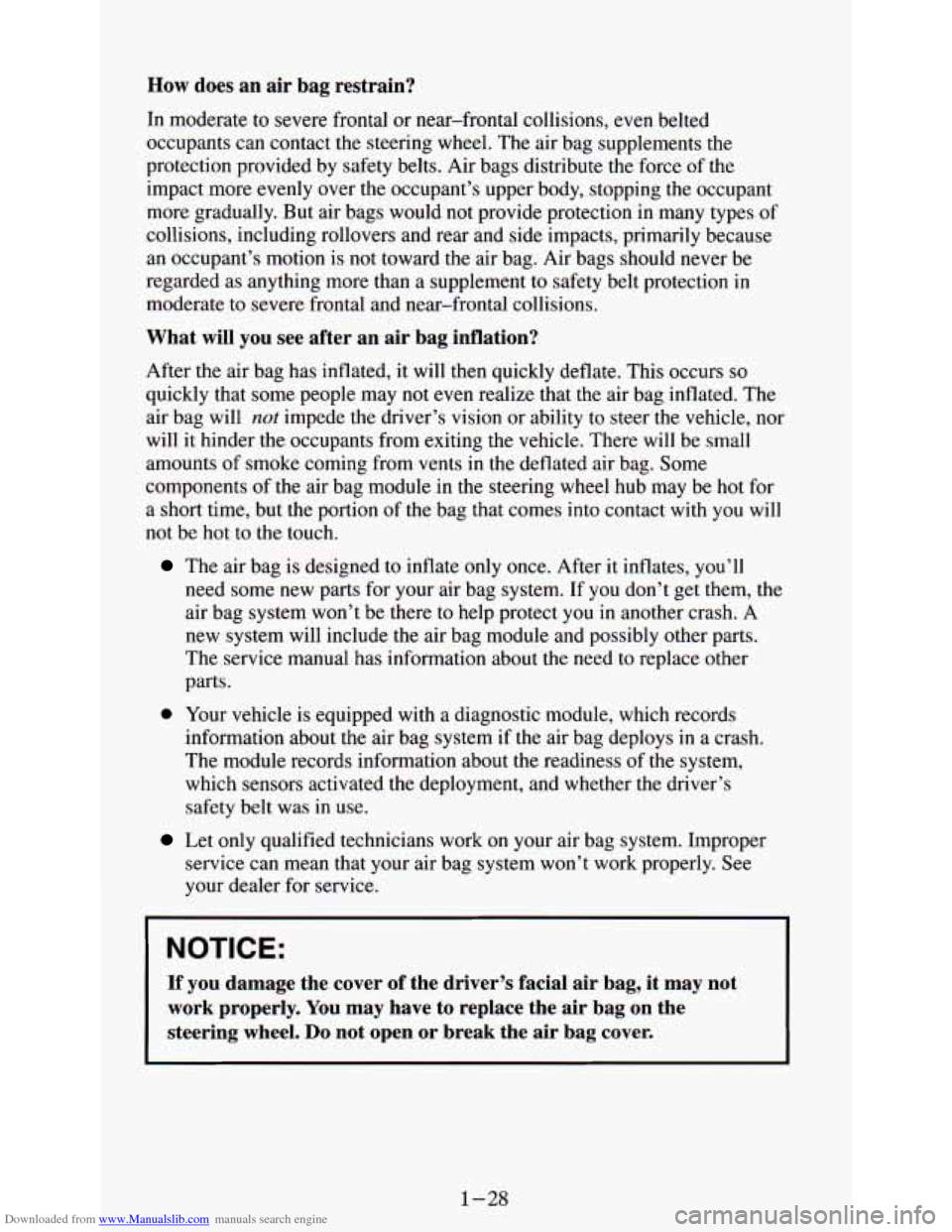
Downloaded from www.Manualslib.com manuals search engine How does an air bag restrain?
In moderate to severe frontal or near-frontal collisions, even belted
occupants can contact the steering wheel. The air bag supplements the
protection provided by safety belts. Air bags distribute the force of the
impact more evenly over the occupant’s upper body, stopping the occupant
more gradually. But air bags would not provide protection in m\
any types of
collisions, including rollovers and rear and side impacts, primarily because
an occupant’s motion is not toward the air bag. Air bags should never be
regarded as anything more than a supplement to safety belt protection in
moderate to severe frontal and near-frontal collisions.
What will you see after an air bag inflation?
After the air bag has inflated, it will then quickly deflate. This occurs so
quickly that some people may not even realize that the air bag inflated. The
air bag will
not impede the driver’s vision or ability to steer the vehicle, nor
will it hinder the occupants from exiting the vehicle. There will be small
amounts of smoke coming from vents
in the deflated air bag. Some
components of the air bag module
in the steering wheel hub may be hot for
a short time,
but the portion of the bag that comes into contact with you will
not be hot
to the touch.
The air bag is designed to inflate only once. After it inflates, you’ll
need some new parts for your air bag system. If you don’t get them, the
air bag system won’t be there to help protect you
in another crash. A
new system will include the air bag module and possibly other parts.
The service manual
has information about the need to replace other
parts.
0 Your vehicle is equipped with a diagnostic module, which records
information about the air bag system
if the air bag deploys in a crash.
The module records information about the readiness of the system,
which sensors activated the deployment, and whether the driver’s
safety belt was in use.
Let only qualifi.ed technicians work on your air bag system. Improper
service can mean that your air bag system won’t work properly. See
your dealer for service.
NOTICE:
If you damage the cover of the driver’s facial air bag, it ma\
y not
work properly. You may have to replace the air bag on the
steering wheel.
Do not open or break the air bag cover.
1-28
Page 70 of 340
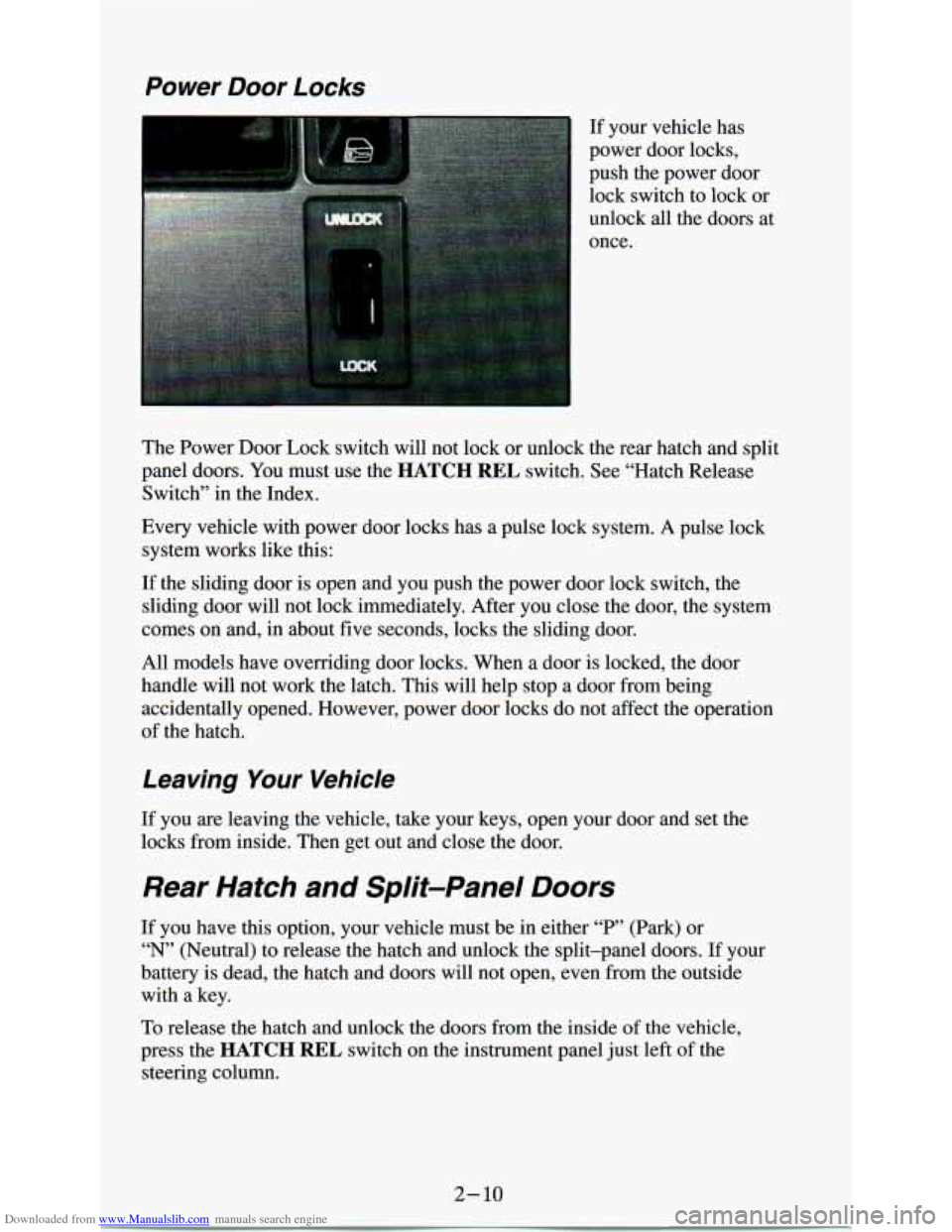
Downloaded from www.Manualslib.com manuals search engine Power Door Locks
If your vehicle has
power door locks,
push the power door
lock switch to lock or
unlock all the doors at
once.
The Power Door Lock switch will not lock or unlock the rear hatch and split
panel doors. You must use the
HATCH REL switch. See “Hatch Release
Switch” in the Index.
Every vehicle with power door locks has a pulse lock system. A pulse lock
system works like this:
If the sliding door is open and you push the power door lock switch, the
sliding door will not lock immediately. After you close the door, the system
comes on and, in about five seconds, locks the sliding door.
All models have overriding door locks. When a door is locked, the door
handle will not work the latch. This will help stop a door from being
accidentally opened. However, power door locks do not affect the operation
of the hatch.
Leaving Your Vehicle
If you are leaving the vehicle, take your keys, open your door and set the
locks from inside. Then get out and close the door.
Rear Hatch and Split-Panel Doors
If you have this option, your vehicle must be in either “P” (Park) or
“N’ (Neutral) to release the hatch and unlock the split-panel doors. If your
battery is dead, the hatch and doors will not open, even from the outside
with a key.
To release the hatch and unlock the doors from the inside of the vehicle,
press
the HATCH REL switch on the instrument panel just left of the
steering column.
2-10
Page 152 of 340
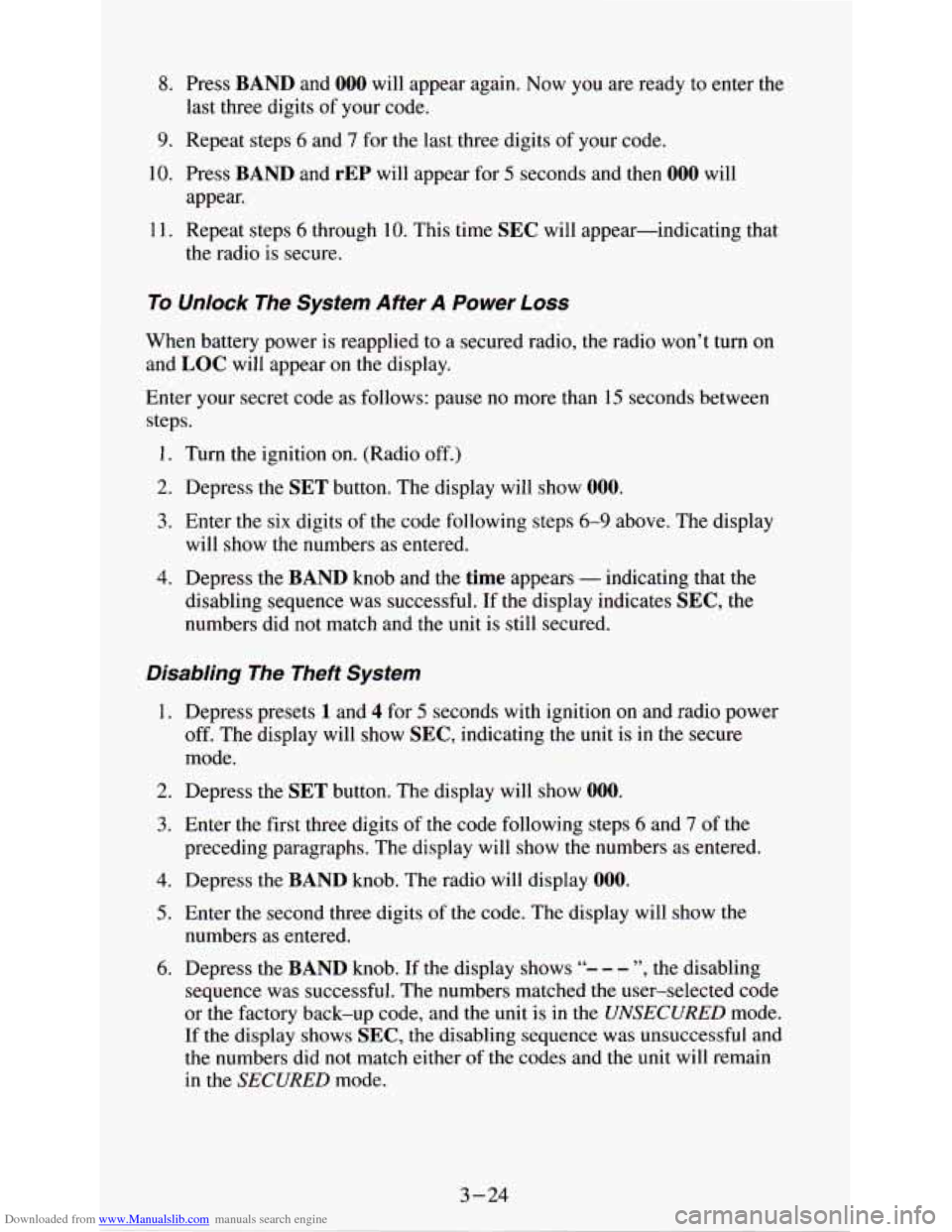
Downloaded from www.Manualslib.com manuals search engine 8. Press BAND and 000 will appear again. Now you are ready to enter the
last three digits of your code.
9. Repeat steps 6 and 7 for the last three digits of your code.
10. Press
BAND and rEP will appear for 5 seconds and then 000 will
11. Repeat steps
6 through 10. This time SEC will appear-indicating that
appear.
the radio
is secure.
To Unlock The System After A Power Loss
When battery power is reapplied to a secured radio, the radio won’t turn on
and
LOC will appear on the display.
Enter your secret code as follows: pause no more than
15 seconds between
steps.
1. Turn the ignition on. (Radio off.)
2. Depress the SET button. The display will show 000.
3. Enter the six digits of the code following steps 6-9 above. The display
4. Depress the BAND knob and the time appears - indicating that the
disabling sequence was successful. If the display indicates
SEC, the
numbers did not match and the unit is still secured.
will show the numbers as entered.
Disabling The Theft System
1.
2.
3.
4.
5.
6.
Depress presets 1 and 4 for 5 seconds with ignition on and radio power
off. The display will show
SEC, indicating the unit is in the secure
mode.
Depress the
SET button. The display will show 000.
Enter the first three digits of the code following steps 6 and 7 of the
preceding paragraphs. The display
will show the numbers as entered.
Depress
the BAND knob. The radio will display 000.
Enter the second three digits of the code. The display will show the
numbers as entered.
Depress the
BAND knob. If the display shows bb- - - ”, the disabling
sequence was successful. The numbers matched the user-selected code
or the factory back-up code, and the unit
is in the UNSECURED mode.
If the display shows
SEC, the disabling sequence was unsuccessful and
the numbers did not match either of the codes and the unit will remain
in the SECURED mode.
3-24
Page 253 of 340
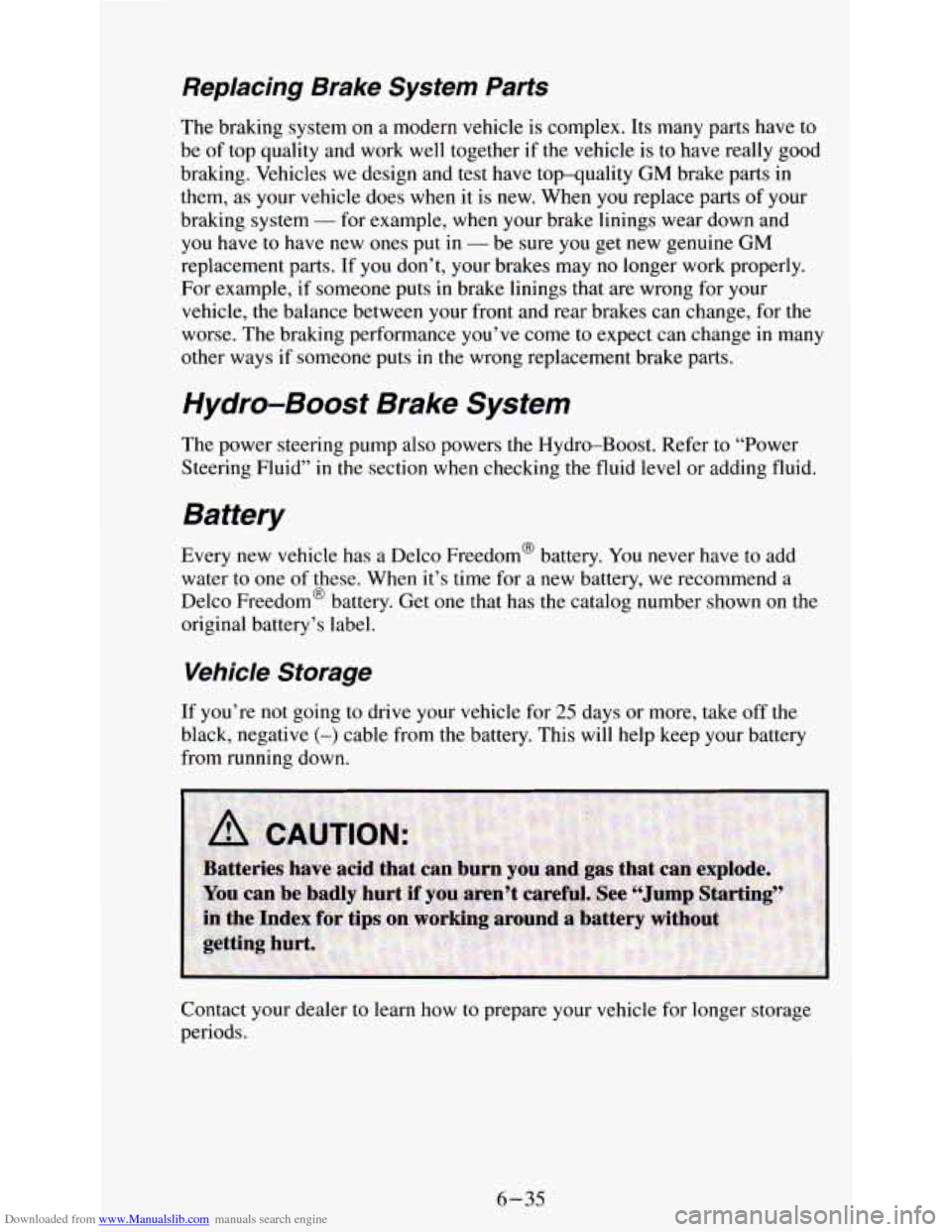
Downloaded from www.Manualslib.com manuals search engine Replacing Brake System Parts
The braking system on a modern vehicle is complex. Its many parts have to
be of top quality and work well together
if the vehicle is to have really good
braking. Vehicles we design and test have top-quality
GM brake parts in
them, as your vehicle does when it is new. When you replace parts of your
braking system
- for example, when your brake linings wear down and
you have to have new ones put in
- be sure you get new genuine GM
replacement parts. If you don’t, your brakes may no longer work properly.
For example,
if someone puts in brake linings that are wrong for your
vehicle, the balance between your front and rear brakes can change, for
the
worse. The braking performance you’ve come to expect can change in many
other ways if someone puts in the wrong replacement brake parts.
Hydro-Boost Brake System
The power steering pump also powers the Hydro-Boost. Refer to “Power
Steering Fluid”
in the section when checking the fluid level or adding fluid.
Battery
Every new vehicle has a Delco Freedom@ battery. You never have to add
water to one
of these. When it’s time for a new battery, we recommend a
Delco Freedom@ battery. Get one that has the catalog number shown on the
original battery’s label.
Vehicle Storage
If you’re not going to drive your vehicle for 25 days or more, take off the
black, negative
(-) cable from the battery. This will help keep your battery
from running down.
Contact your dealer to learn how to prepare your vehicle for longer storage
periods.
6-35
Page 292 of 340
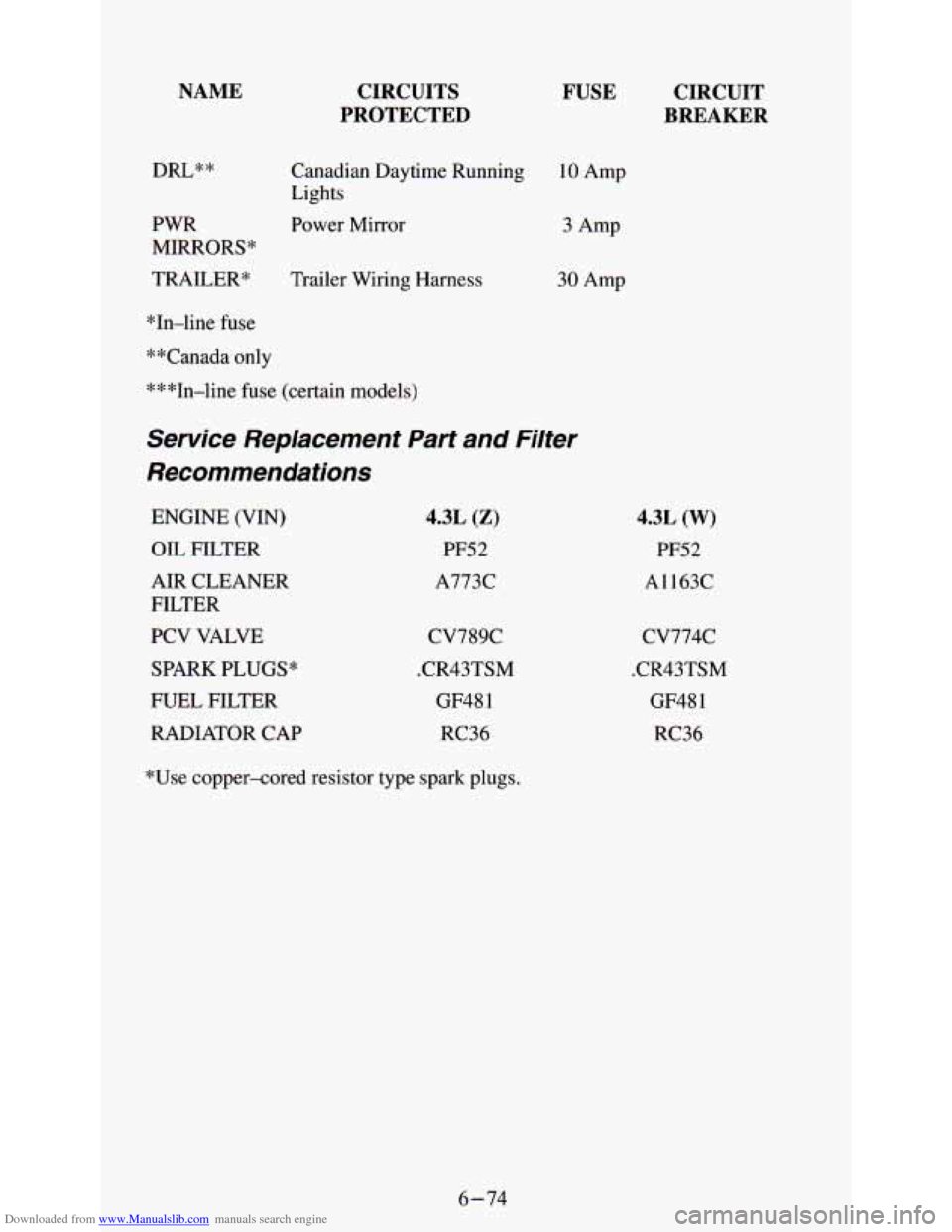
Downloaded from www.Manualslib.com manuals search engine NAME
DRL**
PWR
MIRRORS*
TRAILER*
CIRCUITS
PROTECTED
Canadian Daytime Running
Lights
Power Mirror
Trailer Wiring Harness
FUSE
10 Amp
3 Amp
30 Amp
*In-line fuse
**Canada only
***In-line fuse (certain models)
Service Replacement Part and Filter
Recommendations
ENGINE (VIN)
OIL FILTER
AIR CLEANER FILTER
PCV VALVE
SPARK PLUGS*
FUEL FILTER
RADIATOR CAP 4.3L (2)
PF52
A773C
CV789C
.CR43TSM
GF48
1
RC36
*Use copper-cored resistor type spark plugs.
CIRCUIT
BREAKER
4.3L
(W)
PF52
A1163C
cv774c
.CR43TSM GF48
1
RC36
6-74
Page 320 of 340
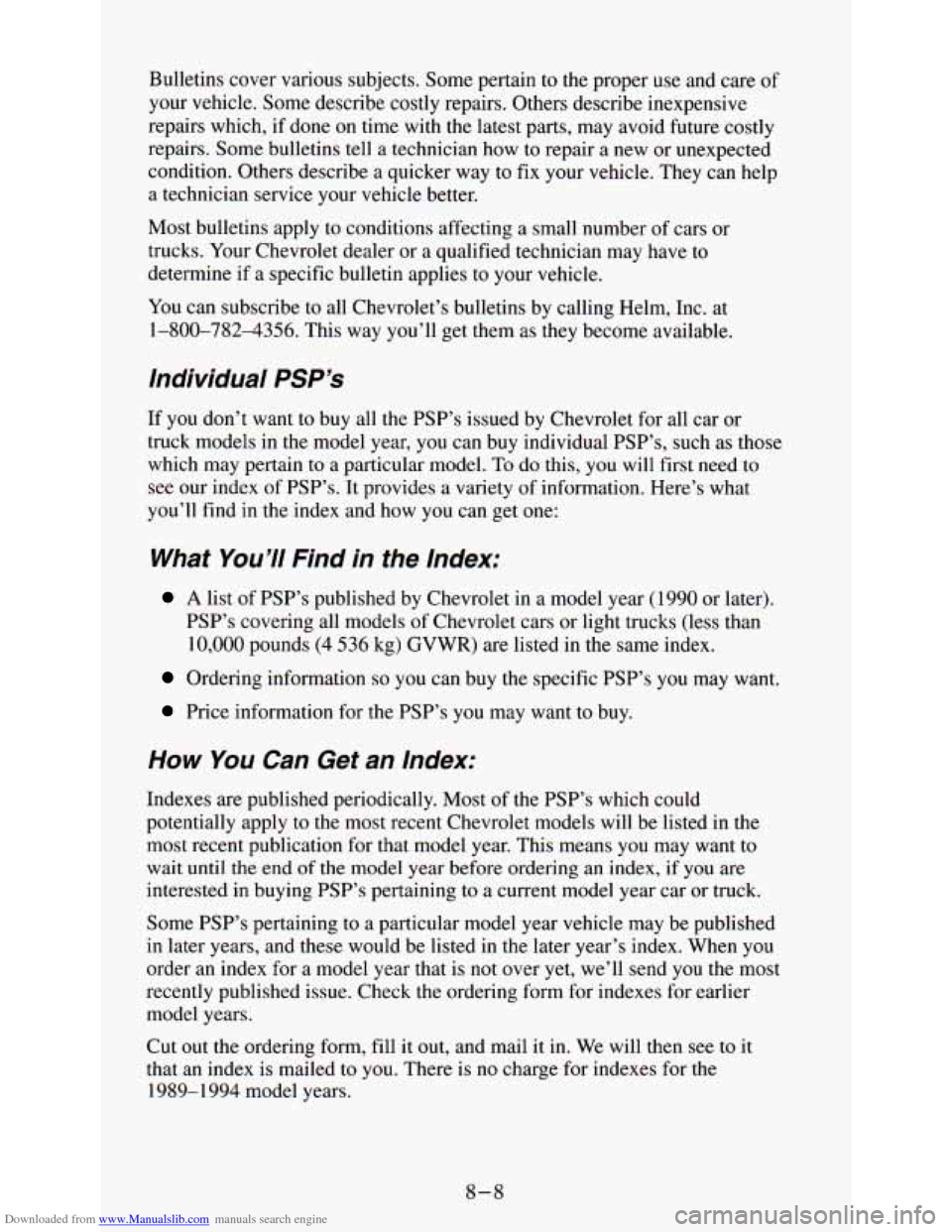
Downloaded from www.Manualslib.com manuals search engine Bulletins cover various subjects. Some pertain to the proper use and care of
your vehicle. Some describe costly repairs. Others describe inexpensive
repairs which, if done
on time with the latest parts, may avoid future costly
repairs. Some bulletins tell a technician how to repair a new or unexpected
condition. Others describe a quicker way to fix your vehicle. They can help
a technician service your vehicle better.
Most bulletins apply to conditions affecting a small number
of cars or
trucks. Your Chevrolet dealer or a qualified technician may have
to
determine if a specific bulletin applies to your vehicle.
You can subscribe
to all Chevrolet’s bulletins by calling Helm, Inc. at
1-800-7824356. This way you’ll get them as they become available.
Individual PSP’s
If you don’t want to buy all the PSP’s issued by Chevrolet for all car or
truck models in the model year,
you can buy individual PSP’s, such as those
which may pertain to a particular model.
To do this, you will first need to
see our index of PSP’s. It provides a variety of information. Here’s what
you’ll find in the index and how you can get one:
What You’// Find in the Index:
A list of PSP’s published by Chevrolet in a model year (1990 or later).
PSP’s covering all models
of Chevrolet cars or light trucks (less than
10,000 pounds (4 536 kg) GVWR) are listed in the same index.
Ordering information so you can buy the specific PSP’s you may want.
Price information for the PSP’s you may want to buy.
How You Can Get an Index:
Indexes are published periodically. Most of the PSP’s which could
potentially apply
to the most recent Chevrolet models will be listed in the
most recent publication for that model year. This means you may want to
wait until
the end of the model year before ordering an index, if you are
interested in buying PSP’s pertaining
to a current model year car or truck.
Some PSP’s pertaining
to a particular model year vehicle may be published
in later years, and these would be listed in the later year’s index. When you
order an index for a model year that is not over yet, we’ll send
you the most
recently published issue. Check the ordering
form for indexes for earlier
model years.
Cut
out the ordering form, fill it out, and mail it in. We will then see to it
that an index is mailed
to you. There is no charge for indexes for the
1989-1 994 model years.
8-8
Page 330 of 340
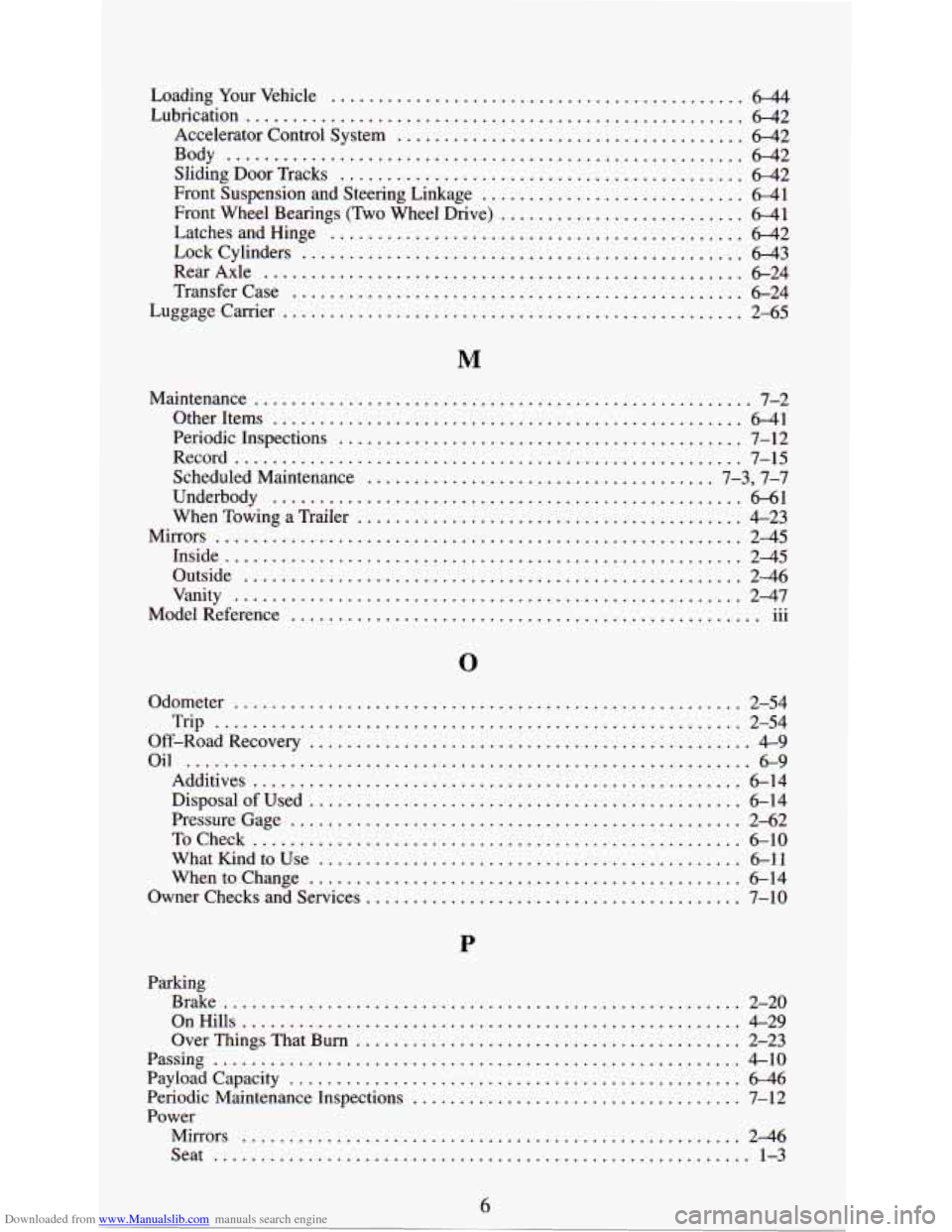
Downloaded from www.Manualslib.com manuals search engine Loading Your Vehicle ........................................ 644
Lubrication ..................................................... 6-42
Accelerator Control System ..................................... 6-42
Body ....................................................... 6-42
Sliding Door Tracks ........................................... 6-42
Front Suspension and Steering Linkage ........... ............. 6-41
Front Wheel Bearings (Two Wheel Drive) .......................... 6-41
LatchesandHinge ............................................ 6-42
Lock Cylinders ............................................... 6-43
Rear Axle ................................................... 6-24
Transfer Case ................................................ 6-24
Luggagecarrier ................................................. 2-65
Maintenance ...... ................................. 7-2
OtherItems ................................................ 6-41
Periodic Inspections ........................................... 7-12
Record ...................................................... 7-15
Scheduled Maintenance ..................................... 7-3, 7-7
Underbody .................................................. 6-61
When Towing a Trailer ......................................... 4-23
Mirrors ....................................... ............. 2-45
Inside .............. ................................ 2-45
Outside ................................................... 2-46
Vanity ...................................................... 2-47
ModelReference .................................................. 111 ...
Odometer ................................................ 2-54
Trip ........................................................ 2-54
Off-RoadRecovery ............................................... 4-9
Oil ............................................................ 6-9
Additives .................................................... 6-14
Disposal of Used .............................................. 6-14
PressureGage ................................................ 2-62
ToCheck .................................................... 6-10
WhatKindtoUse ............................................. 6-11
Whentochange .............................................. 6-14
Owner Checks and Services .................... ............. 7-10
Parking
Brake
....................................................... 2-20
OnHills ..................................................... 4-29
Passing ........................................................ 4-10
Payloadcapacity ................................................ 6-46
Power Over
Things That Burn
......................................... 2-23
Periodic Maintenance Inspections ................................... 7-12
Mirrors ..................................................... 2-46
Seat ......................................................... 1-3